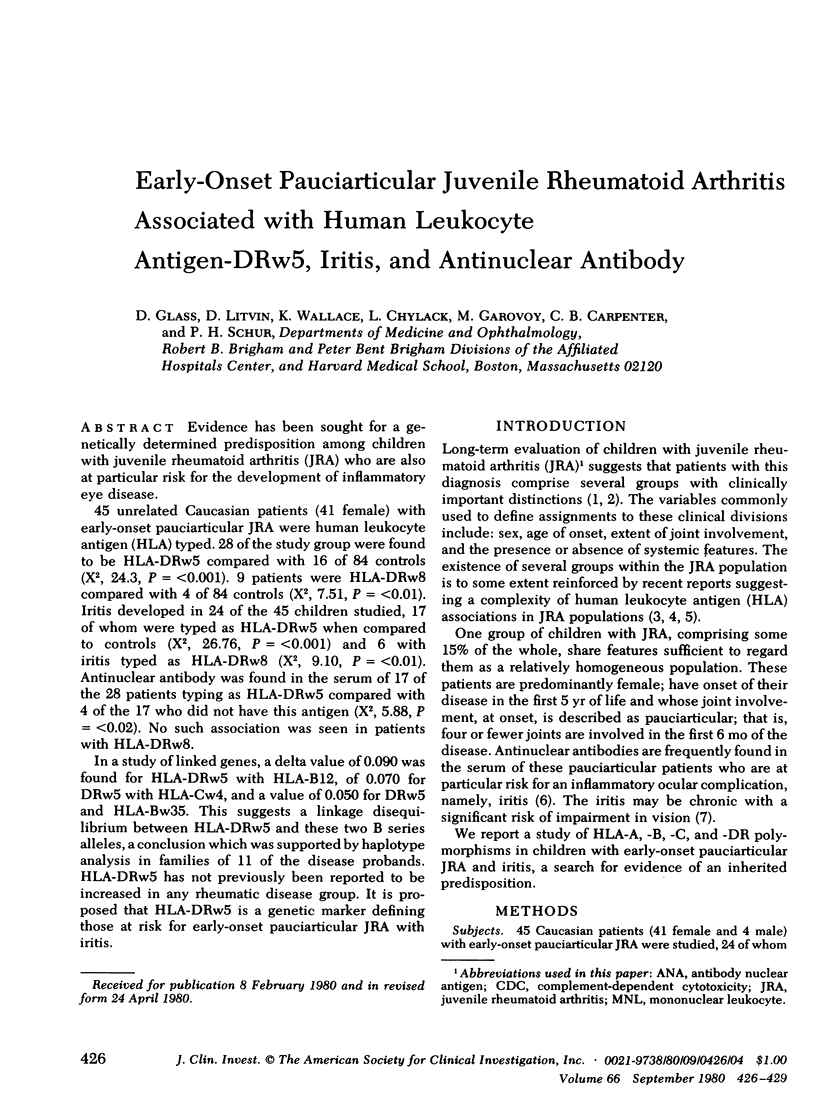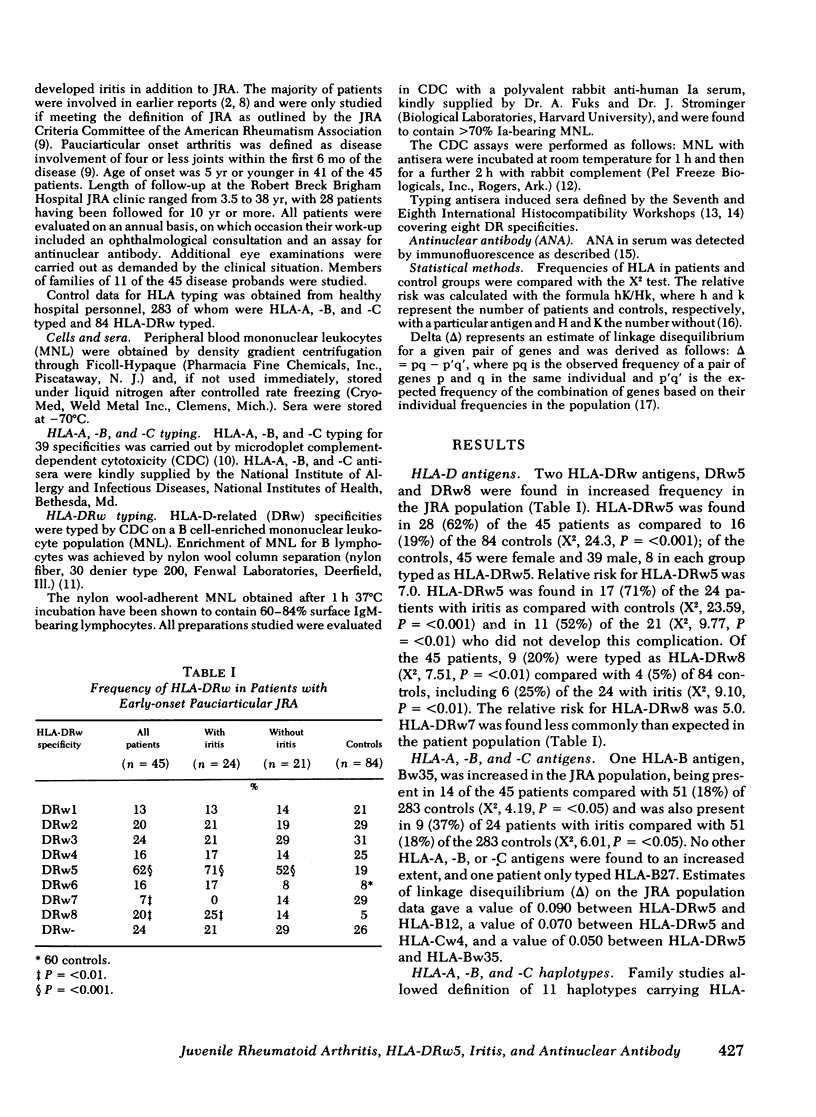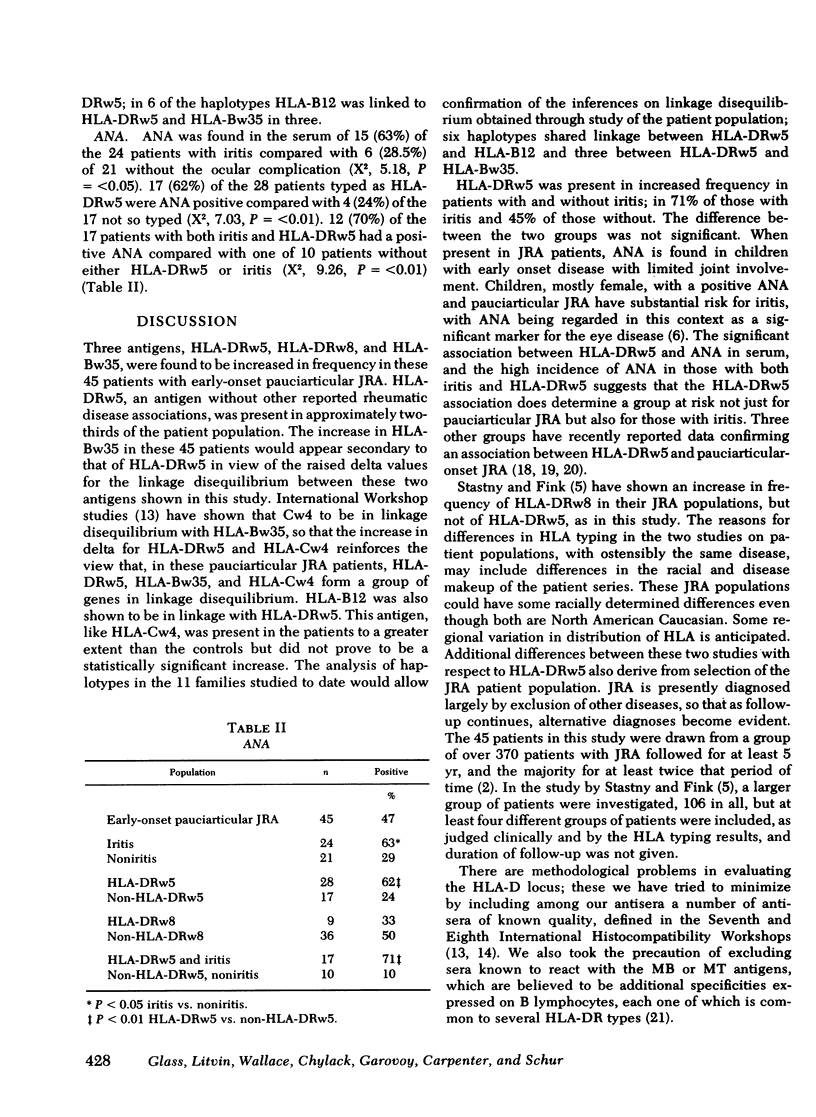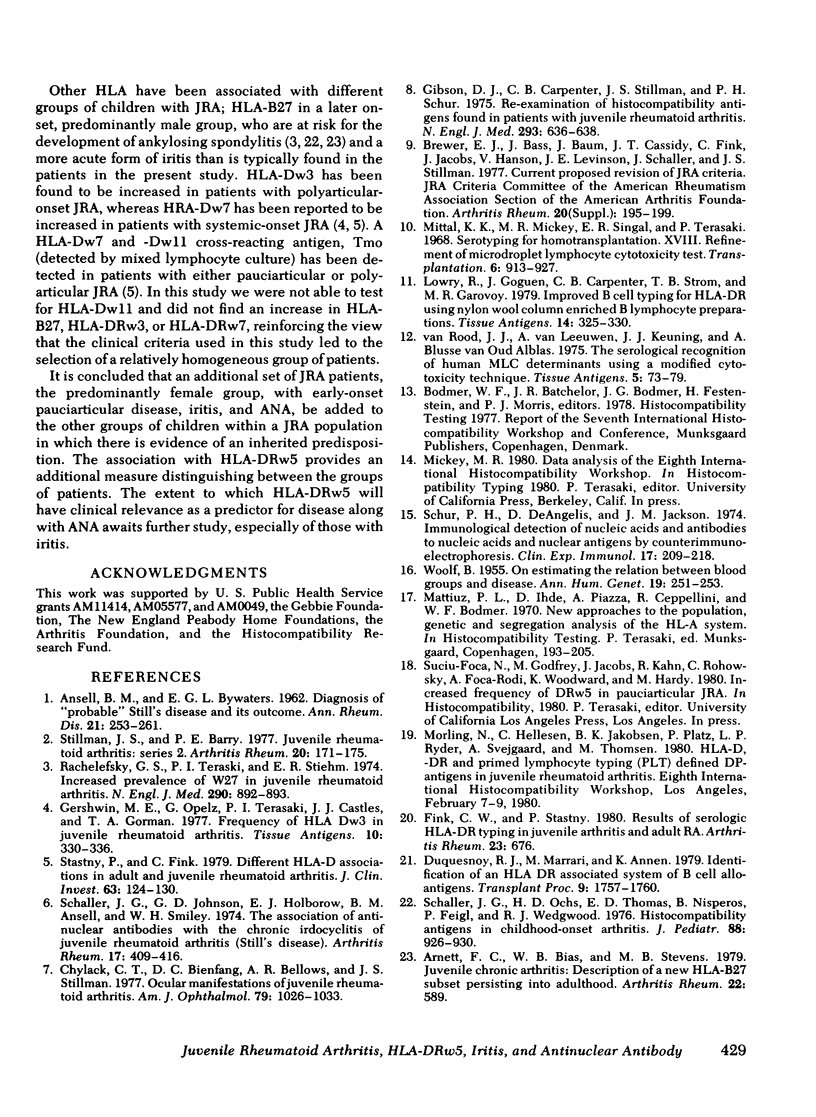Abstract
Evidence has been sought for a genetically determined predisposition among children with juvenile rheumatoid arthritis (JRA) who are also at particular risk for the development of inflammatory eye disease.
45 unrelated Caucasian patients (41 female) with early-onset pauciarticular JRA were human leukocyte antigen (HLA) types. 28 of the study group were found to be HLA-DRw5 compared with 16 of 84 controls (X2, 24.3, P = <0.001). 9 patients were HLA-DRw8 compared with 4 of 84 controls (X2, 7.51, P = <0.01). Iritis developed in 24 of the 45 children studied, 17 of whom were typed as HLA-DRw5 when compared to controls (X2, 26.76, P = <0.001) and 6 with iritis typed as HLA-DRw8 (X2, 9.10, P = <0.01). Antinuclear antibody was found in the serum of 17 of the 28 patients typing as HLA-DRw5 compared with 4 of the 17 who did not have this antigen (X2, 5.88, P = <0.02). No such association was seen in patients with HLA-DRw8.
In a study of linked genes, a delta value of 0.090 was found for HLA-DRw5 with HLA-B12, of 0.070 for DRw5 with HLA-Cw4, and a value of 0.050 for DRw5 and HLA-Bw35. This suggests a linkage disequilibrium between HLA-DRw5 and these two B series alleles, a conclusion which was supported by haplotype analysis in families of 11 of the disease probands. HLA-DRw5 has not previously been reported to be increased in any rheumatic disease group. It is proposed that HLA-DRw5 is a genetic marker defining those at risk for early-onset pauciarticular JRA with iritis.
Full text
PDF



Selected References
These references are in PubMed. This may not be the complete list of references from this article.
- ANSELL B. M., BYWATERS E. G. Diagnosis of "probable" Still's disease and its outcome. Ann Rheum Dis. 1962 Sep;21:253–262. doi: 10.1136/ard.21.3.253. [DOI] [PMC free article] [PubMed] [Google Scholar]
- Brewer E. J., Jr, Bass J., Baum J., Cassidy J. T., Fink C., Jacobs J., Hanson V., Levinson J. E., Schaller J., Stillman J. S. Current proposed revision of JRA Criteria. JRA Criteria Subcommittee of the Diagnostic and Therapeutic Criteria Committee of the American Rheumatism Section of The Arthritis Foundation. Arthritis Rheum. 1977 Mar;20(2 Suppl):195–199. [PubMed] [Google Scholar]
- Chylack L. T., Jr, Bienfang D. C., Bellows A. R., Stillman J. S. Ocular manifestations of juvenile rheumatoid arthritis. Am J Ophthalmol. 1975 Jun;79(6):1026–1033. doi: 10.1016/0002-9394(75)90689-3. [DOI] [PubMed] [Google Scholar]
- Duquesnoy R. J., Marrari M., Annen K. Identification of an HLA-DR-associated system of B-cell alloantigens. Transplant Proc. 1979 Dec;11(4):1757–1760. [PubMed] [Google Scholar]
- Gershwin M. E., Opelz G., Terasaki P. I., Castles J. J., Gorman T. A. Frequency of HLA-Dw3 in juvenile rheumatoid arthritis. Tissue Antigens. 1977 Oct;10(4):330–336. doi: 10.1111/j.1399-0039.1977.tb00765.x. [DOI] [PubMed] [Google Scholar]
- Gibson D. J., Carpenter C. M., Stillman J. S., Schur P. H. Re-examination of histocompatibility antigens found in patients with juvenile rheumatoid arthritis. N Engl J Med. 1975 Sep 25;293(13):636–638. doi: 10.1056/NEJM197509252931305. [DOI] [PubMed] [Google Scholar]
- Lowry R., Goguen J., Carpenter C. B., Strom T. B., Garovoy M. R. Improved B cell typing for HLA-DR using nylon wool column enriched B lymphocyte preparations. Tissue Antigens. 1979 Oct;14(4):325–330. doi: 10.1111/j.1399-0039.1979.tb00856.x. [DOI] [PubMed] [Google Scholar]
- Mittal K. K., Mickey M. R., Singal D. P., Terasaki P. I. Serotyping for homotransplantation. 18. Refinement of microdroplet lymphocyte cytotoxicity test. Transplantation. 1968 Nov;6(8):913–927. doi: 10.1097/00007890-196811000-00006. [DOI] [PubMed] [Google Scholar]
- Rachelefsky G. S., Terasaki P. I., Katz R., Stiehm E. R. Increased prevalence of W27 in juvenile rheumatoid arthritis. N Engl J Med. 1974 Apr 18;290(16):892–893. doi: 10.1056/NEJM197404182901608. [DOI] [PubMed] [Google Scholar]
- Schaller J. G., Johnson G. D., Holborow E. J., Ansell B. M., Smiley W. K. The association of antinuclear antibodies with the chronic iridocyclitis of juvenile rheumatoid arthritis (Still's disease). Arthritis Rheum. 1974 Jul-Aug;17(4):409–416. doi: 10.1002/art.1780170411. [DOI] [PubMed] [Google Scholar]
- Schaller J. G., Ochs H. D., Thomas E. D., Nisperos B., Feigl P., Wedgwood R. J. Histocompatibility antigens in childhood-onset arthritis. J Pediatr. 1976 Jun;88(6):926–930. doi: 10.1016/s0022-3476(76)81043-8. [DOI] [PubMed] [Google Scholar]
- Schur P. H., DeAngelis D., Jackson J. M. Immunological detection of nucleic acids and antibodies to nucleic acids and nuclear antigens by counterimmunoelectrophoresis. Clin Exp Immunol. 1974 May;17(1):209–218. [PMC free article] [PubMed] [Google Scholar]
- Stastny P., Fink C. W. Different HLA-D associations in adult and juvenile rheumatoid arthritis. J Clin Invest. 1979 Jan;63(1):124–130. doi: 10.1172/JCI109265. [DOI] [PMC free article] [PubMed] [Google Scholar]
- Stillman J. S., Barry P. E. Juvenile rheumatoid arthritis: Series 2. Arthritis Rheum. 1977 Mar;20(2 Suppl):171–175. [PubMed] [Google Scholar]
- WOOLF B. On estimating the relation between blood group and disease. Ann Hum Genet. 1955 Jun;19(4):251–253. doi: 10.1111/j.1469-1809.1955.tb01348.x. [DOI] [PubMed] [Google Scholar]
- van Rood J. J., van Leeuwen A., Keuning J. J., van Oud Alblas A. B. The serological recognition of the human MLC determinants using a modified cytotoxicity technique. Tissue Antigens. 1975 Apr;5(2):73–79. doi: 10.1111/j.1399-0039.1975.tb00532.x. [DOI] [PubMed] [Google Scholar]


